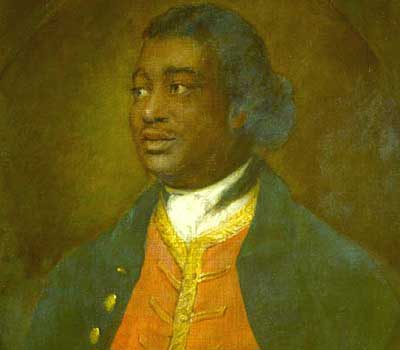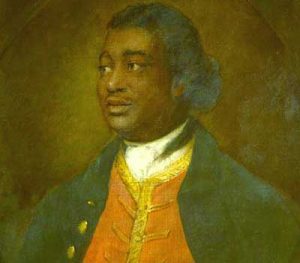
GOOD MORNING P.O.U.!
This week we’ll take a look at Black composers of classical music.
IGNATIUS SANCHO
Ignatius Sancho (c. 1729 – 14 December 1780) was a composer, actor, and writer. He is the first known Black Briton to vote in a British election. He gained fame in his time as “the extraordinary Negro”, and to eighteenth-century Britishabolitionists he became a symbol of the humanity of Africans and immorality of the slave trade.[4] The Letters of the Late Ignatius Sancho, an African, edited and published two years after his death, is one of the earliest accounts of African slavery written in English by a formerslave of Spanish and English families.
Biography
Ignatius Sancho was born on a slave ship in 1729; his precise birthplace is thus unknown. After his mother died in the Spanish colony of New Granadaand his father committed suicide rather than to live as a slave, Sancho was taken to England. From 1731 to 1749, he worked for three maiden sisters inGreenwich. John Montagu, 2nd Duke of Montagu (of the first creation) (1690–1749), impressed by Sancho’s intellect, frankness, and his amiability, not only encouraged him to read, but also lent him books from his personal library at Blackheath. Sancho’s informal education made his lack of freedom in Greenwich unbearable, and he ran away to the Montagus in 1749. For two years until her death in 1751, Sancho worked as the butler for Mary Montagu (née Churchill), Duchess of Montagu, where he flourished by immersing himself in music, poetry, reading, and writing (Ellis 1996:96)[5] (Walvin in King 1997:96)[6] At her death in 1751 he received an annuity of £30 and a year’s salary, which he quickly squandered.[5]
During the 1760s Sancho married a West Indian woman, Ann Osborne. He became a devoted husband and father. They had seven children: Frances Joanna (1761–1815), Ann Alice (1763–1805), Elizabeth Bruce (1766–1837), Jonathan William (1768–1770), Lydia (1771–1776), Katherine Margaret (1773–1779), and William Leach Osborne (1775–1810).[2] Around the time of the birth of their third child, Sancho became a valet to the George Montagu, 1st Duke of Montagu of the second creation, son-in-law of his earlier patron (Ellis 1996:96).[5] He remained there until 1773.
In 1768 Thomas Gainsborough painted a portrait of Sancho at the same time as the Duchess of Montagu sat for her portrait by the artist.(King 1997:28).[1][notes 1] By the late 1760s Sancho had already become accomplished and was considered by many to be a man of refinement (Ellis 1996:96).[5]
In 1766, at the height of the debate about slavery, Sancho wrote to Laurence Sterne[7] encouraging the famous writer to use his pen to lobby for the abolition of the slave trade.[8]
That subject, handled in your striking manner, would ease the yoke (perhaps) of many – but if only one – Gracious God! – what a feast to a benevolent heart!
In July 1766 Sancho’s letter was received by Reverend Laurence Sterne shortly after he had just finished writing a conversation between his fictional characters, Corporal Trim and his brother Tom in Tristram Shandy, wherein Tom described the oppression of a black servant in a sausage shop in Lisbon that he had visited.[9] Laurence Sterne’s widely publicised 27 July 1766 response to Sancho’s letter, became an integral part of 18th-century abolitionist literature.
There is a strange coincidence, Sancho, in the little events (as well as in the great ones) of this world: for I had been writing a tender tale of the sorrows of a friendless poor negro-girl, and my eyes had scarce done smarting with it, when your letter of recommendation in behalf of so many of her brethren and sisters, came to me—but why her brethren?—or your’s, Sancho! any more than mine? It is by the finest tints, and most insensible gradations, that nature descends from the fairest face about St. James’s,1 to the sootiest complexion in Africa: at which tint of these, is it, that the ties of blood are to cease? and how many shades must we descend lower still in the scale, ’ere mercy is to vanish with them?—but ’tis no uncommon thing, my good Sancho, for one half of the world to use the other half of it like brutes, & then endeavor to make ’em so.”[9]
Following the publication of the Sancho-Sterne letters, Sancho became widely known as a man of letters (King 1997:22).[1]
In 1774 with help from Montagu, Sancho, suffering from ill health with thegout, opened a green grocery shop offering merchandise such as tobacco, sugar, and tea at 19 Charles Street in London’s Mayfair,Westminster.[10][notes 2]
As shopkeeper Sancho enjoyed more time to socialise, correspond with his many friends, share his enjoyment of literature, and he attracted many people to his shop. Sancho wrote and published a Theory of Music and two plays. As a financially independent male householder living in Westminster, Sancho qualified to vote in the parliamentary elections of 1774 and 1780; he was the first black person of African origin known to have voted in Britain. At this time he also wrote letters and in newspapers, under his own name and under the pseudonym “Africanus”. He supported the monarchy and British forces in the American Revolutionary War.
Among his acquaintances were celebrated figures such as Thomas Gainsborough, the Shakespearean actor David Garrick, violin virtuoso Felice Giardini, the preacher Dr. Dodd (Ellis 1997:29),[5] The renowned sculptorJoseph Nollekens, and the novelist Laurence Sterne. Nollekin gave Sancho a plaster cast of his c. 1766 marble bust of Laurence Sterne (National Portrait Gallery, London). Sancho received many prominent visitors at his shop, including statesman and abolitionist Charles James Fox PC (1749–1806), who successfully steered a resolution through Parliament pledging it to abolish the slave trade. He oversaw a Foreign Slave Trade Bill in spring 1806 that prohibited British subjects from contributing to the trading of slaves with the colonies of Britain’s wartime enemies, thus eliminating two-thirds of the slave trade passing through British ports.[11][notes 3]
Ignatius Sancho died from the effects of gout on 14 December 1780. He was the first person of African descent known to be given an obituary in the British press.
Letters of the Late Ignatius Sancho
While his correspondence often included domestic issues, also commented on the political and literary life in 18th-century Britain,[3] [8] One of his more famous series of letters includes his eye-witness accounts of the Gordon Riots in June 1780. The angry mob passed outside his shop on Charles Street. The protest that began when Protestants protested against parliamentary extension of Catholic enfranchisement grew into a violent mob of 100, 000 looting and burning parts of London.[12]
There is at this present moment at least a hundred thousand poor, miserable, ragged rabble, from 12 to 60 years of age, with blue cockades in their hats – besides half as many women and children, all parading the streets, the bridge, the park, ready for any and every mischief. Gracious God! What’s the matter now? I was obliged to leave off – ths shouts of the mob, the horrid clashing of swords, and the clutter of a multitude in swiftest motion drew me to the door, when everyone in the street was employed in shutting up shop. It is now just five o’clock – the ballad-singers are exhasting their musical talents with the downfall of Popery, S-h and N-h, Lord S-h narrowly escaped with his life about an hour since’ the mob seized his chariot going to the house, broke his glasses and, in struggling to get his lordship out, they somehow have cut his face.
In 1782 Frances Crewe, a correspondent with Sancho, arranged for 160 of his letters to be published in the form of two-volumes entitled, The Letters of the Late Ignatius Sancho, an African. The book sold very well, with more than 2000 subscribing to it. His widow received more than £500 in royalties.Joseph Jekyll provided the memoirs to the first edition, which was reprinted with each additional edition including the fifth edition published by Sancho’s son in 1803.[13]
His son, William Leach Osborne, inherited the shop and transformed it into a printing and book-selling business. He printed a fifth edition of Letters of the Late Ignatius Sancho with Memoirs of His Life by Joseph Jekyll[10] and the frontispiece engraving by Bartolozzi,[14] in 1803 at this shop on Charles Street.
On slavery
Sancho was unusually blunt in his response to a letter from Jack Wingrave, John Wingrave’s son. Jack wrote about his negative reaction to people of colour based on his own experience in India during the 1770s. Sancho’s friend, John was a London bookbinder and bookseller.[15]
I am sorry to observe that the practice of your country (which as a resident I love – and for its freedom – and for the many blessings I enjoy in it – shall ever have my warmest wishes, prayers and blessings); I say it is with reluctance, that I must observe your country’s conduct has been uniformly wicked in the East – West-Indies – and even on the coast of Guinea. The grand object of English navigators – indeed of all Christian navigators – is money – money – money – for which I do not pretend to blame them – Commerce was meant by the goodness of the Deity to diffuse the various goods of the earth into every part—to unite mankind in the blessed chains of brotherly love – society – and mutual dependence: the enlightened Christian should diffuse the riches of the Gospel of peace – with the commodities of his respective land – Commerce attended with strict honesty – and with Religion for its companion – would be a blessing to every shore it touched at. In Africa, the poor wretched natives blessed with the most fertile and luxuriant soil- are rendered so much the more miserable for what Providence meant as a blessing: the Christians’ abominable traffic for slaves and the horrid cruelty and treachery of the petty Kings encouraged by their Christian customers who carry them strong liquors to enflame their national madness – and powder – and bad fire-arms – to furnish them with the hellish means of killing and kidnapping.[15][16]
Legacy
- A plaque to the memory of Sancho was unveiled on 15 June 2007, by Nick Raynsford, MP for Greenwich, on the remaining wall of Montague House on the south-west boundary of Greenwich Park. The plaque was funded by Friends of Greenwich Park to commemorate the bicentenary of theAbolition of the Slave Trade Act, made law in 1807. A second plaque to his memory is on the Foreign and Commonwealth Office.
- When the city of Westminster commemorated the bicentenary by creating a walking tour of Westminster highlighting events and individuals involved in the campaign to abolish the slave trade, they included 19 Charles Street. This was a collaboration with historian Steve Martin, the National Gallery, the National Portrait Gallery, London, the Palace of Westminster, Tate Britain, Westminster City Archives, and Westminster City Council.[10]
- Sancho features on the list of “100 Great Black Britons”.[17]
- The iconic “Portrait of an African” (probably Ignatius Sancho). Attributed to Allan Ramsay (1713–1784). Oil on canvas 61.8 x 51.5 cm c.1757–59. A full account of the attribution to Ramsay and identification of Sancho is contained in the article “The Lost African” published in Apollo magazine, August 2006.
- In 2015, a play based on the life of Ignatius Sancho, entitled Sancho: An Act of Remembrance, written and performed by Paterson Joseph was staged Oxford and Birmingham in the United Kingdom,[18] and at the Brooklyn Academy of Music in New York.[19]
(SOURCE: Wikipedia)

